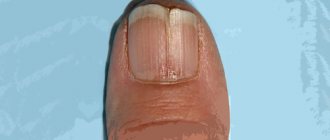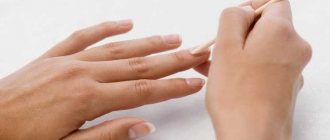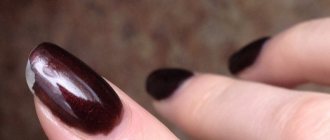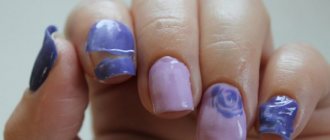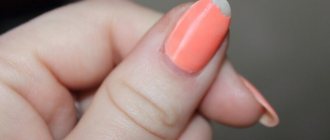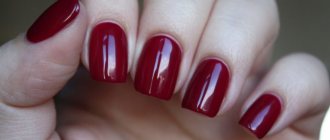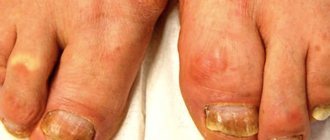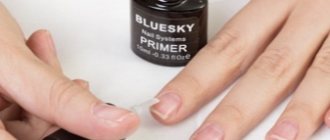05/24/2018 Many people who discover a spot under their nail begin to search on the Internet to find out what it could be? And it turns out that this can be a fatal disease - subungual melanoma.
In this article we will look at:
- concept of subungual melanoma;
- the chances of this type of tumor occurring;
- photos of symptoms with histological confirmation;
- ways to distinguish subungual melanoma from hematoma;
- procedures to clarify the diagnosis;
- prognosis and treatment.
Subungual melanoma – what is it?
The share of melanoma among skin tumors is only 4%. But it is from this malignant neoplasm that 80% of patients with skin tumors die [1]. In Russia, about 8,717 people a year currently develop skin melanoma (data for 2012) [2]. Subungual melanoma is located in the nail bed and usually appears as a stripe on the nail.
Sign up for the webinar “Carcinogens in cosmetics: truth, lies and... marketing”
Types of diseases that cause stripes to appear on fingernails
The appearance of longitudinal stripes on the nail is called leukonychia. Pathology can appear gradually with white spots and bumps or affect the area suddenly.
Diseases in which such a symptom appears are of a different nature. The first group of pathologies is in the nature of fungal infections of the nail plate. It may appear after an unsuccessful manicure, when infected from another person, if the patient has skin diseases, for example, psoriasis.
A characteristic symptom of a fungal infection is itching around the nail, brittleness and burning. In addition to white, nails can be painted black. Dermatological problems also include infection with lichen planus, the development of rheumatoid arthritis or gout.
As a result of chemotherapy and the development of malignant tumors, the human body suffers from vitamin deficiency. For this reason, white lines are often observed in cancer patients. If the stripe turns blue, then the root of the problem lies in liver disease.
Red streaks are the result of hemorrhage within the nail tissue. The reason is blockage of blood vessels and blood clots, which in turn appear along with problems of the cardiovascular system. When such stripes appear, the heart must be examined first.
White stripes often appear after bruises and blows (they can also be red), as a result of a long diet or poor hygiene. If nothing bothers a person other than a change in color, then the problem can be solved with proper nutrition and preventive measures.
Yellow spots may appear on the nails. This indicates pathologies of the liver and kidneys, vitamin deficiency, and a violation of the integrity of the nail matrix. Also, yellow furrows may appear in response to the body's reaction after taking specific medications, prolonged smoking and working with chemicals.
Longitudinal stripes on brown nails can form as a result of injuries and bruises. In this case there is no cause for concern. If the furrows appear spontaneously, perhaps the cause lies in the pathology of the adrenal glands, hemochromatosis or arsenic poisoning. If the brown spot quickly grows and covers the entire surface of the nail, the cause may be melanoma.
The most serious disorders are characterized by the appearance of black bumps. The cause is many factors: diseases of the cardiovascular system, pathologies of the gastrointestinal tract, fungal diseases, arthritis, trichinosis, reaction to taking medications. In some cases, the black color indicates frozen blood clots under the nail, formed after an injury.
In old age, the appearance of black stripes can be explained by the development of vascular atherosclerosis.
The formation of grooves on the nails cannot be ignored, as it is often a signal of diseases of various body systems. Even if the stripes disappear on their own, there is no guarantee that they will not appear again.
What are the chances of this type of tumor occurring in a resident of Russia?
Of the total number of melanomas, the share of this tumor is only 2% [3], i.e., in absolute values, in 170 people per year. Against the background of the country's total population of 146,000,000, this, in my opinion, is very small. At the same time, a low incidence rate does not eliminate the possibility of getting sick.
For representatives of other skin phototypes other than 2, the chances may be very different. Representatives of the Mongoloid and Negroid races have a higher (up to 40%) chance of developing melanoma of the nail bed [4, 5].
Where does subungual melanoma appear most often?
The tumor most often affects the big toes [3].
Diagnosis of the formation of longitudinal stripes on nails
First of all, diagnosis consists of an external examination of the nail plate. The doctor asks the patient about other symptoms and reasons after which the nail began to deform.
After analysis, the following studies are prescribed:
- analysis for fungal infection and other pathologies of the nail plate;
- a nail biopsy, during which a small amount of tissue is taken from the formed strips for examination;
- complete blood count to confirm or rule out other diseases;
- Ultrasound of internal organs (focus on the liver);
- diagnosis of the state of the cardiovascular system, since discoloration of nails and furrows often appear due to heart problems.
Testing for fungal infection and a biopsy of the nail plate are carried out in dermatological clinics. The cost of analysis is from 820 rubles, biopsy – from 500 rubles. The cost of a full ultrasound of internal organs starts from 1,500 rubles.
What does subungual melanoma look like? Photos and signs.
All pictures below are histologically confirmed and not taken from the Internet. The source is indicated in square brackets. There are 2 most common signs:
Sign I
Most often, subungual melanoma appears as a brown or black stripe. The strip starts from the nail fold and ends at the edge of the nail. This condition is called longitudinal melanonychia. Some medications can cause such bands to appear - retinoids and Docetaxel (Taxotere) [10]. This sign can also occur in conditions not associated with melanoma, for example, with fungal infection of the nail, pigmented nevus of the nail bed.
Subungual pigmented nevus in a 13-year-old boy [9]
Subungual melanoma stage I, 0.2 mm according to Breslow [10]
Sign II
The most common sign of this type of melanoma is Hutchinson's sign - a transition of pigmentation to the nail fold or fingertip. This feature is visible in 7 of the 8 images below. At the same time, it cannot be stated unequivocally that this symptom occurs only with melanoma. It can also be observed with a transparent cuticle [10].
8 cases of subungual melanomas in situ (initial stage) [6]
Subungual melanoma of the thumb with level 4 invasion according to Clark, thickness according to Breslow is not specified [8]
Subungual melanoma, Breslow thickness 1.5 mm [7]
Why do stripes appear on fingernails?
Longitudinal stripes on nails are a common occurrence in people of all ages. However, not everyone pays attention to the body’s reaction and waits for the defect to disappear on its own. The stripes usually develop from small spots, gradually growing in different directions. With more serious diseases, the nail plate begins to deform and take on a wave-like shape.
There are various reasons for the appearance of stripes, among them there are both minor factors and serious deviations:
- Improperly performed manicure, in particular damage to the cuticle area.
- Unbalanced food intake, lack of vitamins, impaired metabolism, excessive consumption of carbohydrates, deficiency of iron and B vitamins.
- Disturbances of the endocrine system. For this reason, the problem often appears in overweight people and people with diabetes.
- Destructive processes in the nervous system.
- Skin diseases.
- Unsuccessful nail extensions, as chemicals destroy the structure of the plate.
- Diseases of the stomach and intestines.
- Problems with blood circulation.
- Experienced stress or strain (psychological or physical).
- Recent serious illness (jaundice, influenza, scarlet fever).
- Nail injury that distorts the plate.
Injuries cause the appearance of longitudinal stripes on the nails for a short time
It should be remembered that changes in the structure of the nail are not always a sign of disease. This phenomenon can be observed as a result of age-related changes and hormonal imbalances.
How to distinguish subungual melanoma from everything else?
Here is a fairly simple algorithm.
Algorithm for the differential diagnosis of benign melanonychia and the same condition in melanoma [8]
ABCDEF rule for diagnosing nail bed melanoma
And (age) age - the peak incidence of subungual melanoma occurs between the ages of 50 and 70 years, and also denotes races with an increased risk: Asians, Africans - they account for 1/3 of all melanoma cases.
B (brown to black) – the color is brown and black, with a stripe width of more than 3 mm and blurry boundaries.
C (change) – change in the color of the nail plate or no change after treatment. D (digit) – finger as the most common site of injury.
E (extension) - spread of pigmentation to the nail fold or fingertip (Hutchinson's symptom).
F (Family) – relatives or the patient have a history of melanoma or dysplastic nevus syndrome. [eleven]
How to distinguish a hematoma from a subungual melanoma by dermatoscopy
Hematoma: [10]
- It moves under the nail along with its growth. You can track this by taking a photo of the formation against the background of a ruler located longitudinally. It is important to note that a hematoma does not always appear due to trauma.
- Color from red-blue to black-blue.
- Does not transfer to the cuticle, nail fold and fingertip.
- Does not involve the entire nail in the longitudinal direction.
- May change within a few weeks.
- The color intensity decreases from the center to the periphery.
- It may be preceded by trauma.
- Small blood spots oriented towards the edge of the nail on dermatoscopy
Subungual melanoma: [12]
- Heterogeneous color, irregular stripes with melanonychia.
- Triangular stripes.
- Spreads on the nail plate, free edge of the nail or fingertip.
- Destruction or dystrophy of the nail.
Injuries
Subungual hemorrhages, which form when the upper phalanx of the fingers are injured, are caused by blows, pinching, or falling of a heavy object. Under strong mechanical stress, the capillaries that permeate the nail bed burst, and blood seeps into the subungual space.
Depending on the severity of the injury, the color of the spots can be blue-black, brown, or dark brown. In shape, they look like black dots, stripes under the nails like splinters or round hematomas.
If the described signs are present on only one finger, it is most likely due to injury. Try to remember if you recently hit yourself, if you dropped something heavy on your finger, or if it was accidentally pinched?
Hematoma often occurs in athletes due to bruises or other injuries, or when wearing uncomfortable sports shoes for a long time. Usually black spots and spots appear under the nails on the big toes, since they bear the brunt of the load and are in close contact with the shoes.
In women, black spots on the toes under the toenails are caused by unsuitable shoes. If you wear shoes with high heels or tapered toes all day, the edges of the toes rest and the tissues of the nail bed are compressed and injured.
Bibliography
- Miller AJ, Mihm MC. Melanoma. N Engl J Med. 2006; 355:51-65.
- Data from the Globocan 2012 study, International Agency for Research on Cancer (IARC): https://gco.iarc.fr/today/online-analysis-multi-bars?mode=cancer&mode_population=hdi&population=643&sex=0&cancer=29&type=0&statistic=0&prevalence= 0&color_palette=default
- Kuchelmeister C, Schaumburg-Lever G, Garbe C. Acral cutaneous melanoma in caucasians: clinical features, histopathology and prognosis in 112 patients // J. Dermatol. – 2000
- Takematsu H, Obata M, Tomita Y. Subungual melanoma. A clinicopathologic study of 16 Japanese cases // Cancer. – 1985
- Wu XC, Eide MJ, King J. Racial and ethnic variations in incidence and survival of cutaneous melanoma in the United States, 1999–2006 // J. Am. Acad. Dermatol. – 2011.
- Jae Ho Lee, Ji-Hye Park, Jong Hee Lee, Dong-Youn Lee. Early Detection of Subungual Melanoma In Situ: Proposal of ABCD Strategy in Clinical Practice Based on Case Series Ann Dermatol. Feb 2022; 30(1): 36–40.
- Stephan Braun, MD and Peter Gerber, MD. Subungual malignant melanoma. CMAJ. 2015 Sep 8; 187(12): 909.
- Pierre Halteh, Richard Scher, MD, FACP, Amanda Artis, MS, MPH, and Shari R. Lipner, MD, PhD. A Survey Based Study of Management of Longitudinal Melanonychia Amongst Attending and Resident Dermatologists. J Am Acad Dermatol. May 2022; 76(5): 994–996.
- Kamran Khan and Arun A Mavanur. Longitudinal melanonychia. BMJ Case Rep. 2015; 2015: bcr2015213459.
- Holger A. Haenssle, Andreas Blum, Rainer Hofmann-Wellenhof, Juergen Kreusch, Wilhelm Stolz, Giuseppe Argenziano, Iris Zalaudek, and Franziska Brehmer. When all you have is a dermatoscope— start looking at the nails. Dermatol Pract Concept. 2014 Oct; 4(4): 11–20.
- Levit EK, Kagen MH, Scher RK, Grossman M, Altman E. The ABC rule for clinical detection of subungual melanoma. J Am Acad Dermatol. 2000 Feb;42(2 Pt 1):269-74.
- Haenssle HA, Brehmer F, Zalaudek I, Hofmann-Wellenhof R, Kreusch J, Stolz W, Argenziano G, Blum A. Dermoscopy of nails. Hautarzt. 2014 Apr;65(4):301-11. doi: 10.1007/s00105-013-2707-x.
Other factors
- A person’s lifestyle – regular violation of a healthy routine sooner or later leads to malfunctions in the body’s functioning. This can also affect the condition of the nail plates. If black stripes or other changes in structure appear, you should reconsider your lifestyle. People are advised to alternate between rest and work, get full sleep at night (at least 7-8 hours), normalize their diet (include proteins, long-term carbohydrates and vegetable fats), maintain a drinking regime, and walk in the fresh air.
- It is also necessary to play sports, if this is not possible, then take regular walks. For example: walk a couple of stops to work, take the stairs rather than the elevator, etc.
- Autoimmune diseases - with such diseases, stripes may appear under the nails. Often, deformation is observed in rheumatoid arthritis, lupus erythematosus, and psoriasis.
- Malfunction of the adrenal glands.
- Stripes appear with vasculitis - inflammation of the blood vessels, endocarditis (heart infection), anemia and melanoma.
Many people don't know what the stripes under their nails mean. They begin to panic, looking for serious illnesses. But only a doctor can diagnose the disease after conducting the necessary tests.
What do white stripes mean?
Sometimes people experience white stripes on their nail plates. They appear as a result of internal or external factors.
- injuries to fingers and nail plates;
- poorly performed manicure or pedicure;
- exposure to aggressive chemicals – house cleaning products, etc.;
- taking a number of serious medications (antibiotics);
- dysfunction of the thyroid glands - diabetes mellitus or other malfunctions of the endocrine gland;
- nervous exhaustion, being under constant stress or prolonged depression.
